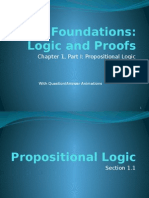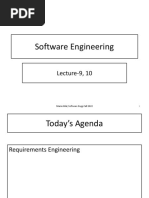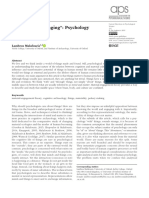DS Assignment-1 Solution
Uploaded by
Tayyab HusaainDS Assignment-1 Solution
Uploaded by
Tayyab HusaainQ.1. There are five friends having access to a chat room.
Is it possible to determine who is chatting
if the following information is known? Explain your reasoning. (6 marks)
1. Either Kamal or Haider, or both, are chatting.
2. Either Raheem or Waqas, but not both, are chatting.
3. If Ahmad is chatting, so is Raheem.
4. Waqas and Kamal are either both chatting or neither is.
5. If Haider is chatting, then so are Ahmad and Kamal.
Solution:
It’s easiest to use symbolic notation. Then we have the following five propositions.
1. K ∨ H.
2. R ⊕ W .
3. A → R.
4. W ↔ K.
5. H → A ∧ K.
There are many ways to proceed. Here’s one. Note that 1 and 5 both involve K and H. 1 says either K
or H, but 5 says that if H, then also A ∧ K, so K in that case, too. Thus, H occurs whenever K occurs, so
in all cases K. Now 1 is satisfied. So we now know K. By 4, therefore also W, and 4 is now satisfied. By
2, therefore ¬R, and 2 is satisfied. Then by 3, therefore ¬A, and 3 is satisfied. But by 5, since ¬A,
therefore ¬H, and 5 is satisfied. By now, we’ve satisfied all five statements in the only way possible,
namely, with K, W , but not R, not A, and not H. Thus, the answer to the question is: we can conclude
that Kamal and Waqas are chatting, but the other three aren’t.
Another way is to make truth table of whole scenario and find the values where all 5 propositions
are true.
Q.2. Translate the given statement into propositional logic. (5+5 marks)
Solution:
a. You cannot edit a protected Wikipedia entry unless you are an administrator. Express your
answer in terms of e: “You can edit a protected Wikipedia entry” and a: “You are an
administrator.”
Lets consider p→q. Another way to express this implication is q unless ∼p.
Now coming to this problem: Whenever there is unless in the statement, remove it and put NOT to
the statement after it. e.g: You cannot edit a protected Wikipedia entry unless you are an
administrator. You cannot edit a protected Wikipedia entry, you are NOT an administrator. Now,
You cannot edit a protected Wikipedia = ∼e
you are NOT an administrator = ∼a
So required propositional logic is ∼a→∼e
b. You are eligible to be President of the U.S.A. only if you are at least 35 years old, were born in
the U.S.A, or at the time of your birth both of your parents were citizens, and you have lived at
least 14 years in the country.
e: “You are eligible to be President of the U.S.A.,”
a: “You are at least 35 years old,”
b: “You were born in the U.S.A,”
p: “At the time of your birth, both of your parents where citizens,”
r: “You have lived at least 14 years in the U.S.A.”
So from that here are three conditions that has to be satisfied
1. Above 35 years
2. Born in USA or Parents were in USA
3. lived above 14 years
As they have to be satisfied together so AND operator is to be used. So the answer is
(a^(bvp)^r)→e
Q.3. Express these system specifications using the propositions p “The message is scanned for
viruses” and q “The message was sent from an unknown system” together with logical connectives
(including negations).
a) “The message is scanned for viruses whenever the message was sent from an unknown
system.”
b) “The message was sent from an unknown system but it was not scanned for viruses.”
c) “It is necessary to scan the message for viruses whenever it was sent from an unknown system.”
d) “When a message is not sent from an unknown system it is not scanned for viruses.”
Solution:
p = "The message is scanned for viruses"
q = "The message was sent from an unknown system"
a) Replace the known sub-statements by p and q in the given statement:
=> p whenever q
=> q → p
b) Replace the known sub-statements by p and q in the given statement:
=> q but not p
"but" implies "and"
=> q and not p
=> q ∧ ¬p
c) Replace the known sub-statements by p and q in the given statement:
=> p whenever q
=> q → p
d) Replace the known sub-statements by p and q in the given statement:
=> when not q then not p
"q when p" is equivalent with "if p, then q":
if not q then not p
Replace "if-then" by → and "not" by ¬
¬q→¬p
Q.4. Use De Morgan’s laws to find the negation of each of the following statements.
a) Kamal will take a job in industry or go to graduate school.
b) Yusuf knows Java and calculus.
c) Junaid is young and strong.
d) Raheem will move to Oregon or Washington.
Solution:
1. The negation of “Kamal will take a job in industry or go to graduate school” is “Kamal will not take
a job in industry and will not go to graduate school,” or “Kamal will neither go to industry nor go to
graduate school.”
2. The negation of “Yusuf knows Java and calculus” is “Yusuf does not know Java or does not know
calculus,” or (more naturally, though ignoring De Morgan’s Law) “Yusuf does not know both Java and
calculus.” The answer “Yusuf does not know Java or calculus” is incorrect, as this implies that Yusuf
knows neither. Because of the structure of English sentences, you cannot negate the proposition
simply by switching “does” with “does not” and “and” with “or.”
3. The negation of “Junaid is young and strong” is “Junaid is not young or not strong.” The answer
“Junaid is not young or strong” is incorrect since this implies that he is neither.
4. The negation of “Raheem will move to Oregon or Washington” is “Raheem will not move to
Oregon and will not move to Washington.” The answer “Raheem will not move to Oregon and
Washington” is incorrect, since this implies that she will not move to both states where we want to
say that she will not move to either.
Another way to do this is:
a) Neither Kamal will take a job in industry nor will he go to graduate school.
b) Either Yusuf does not know Java or he does not know calculus.
c) Either Junaid is not young or he is not strong.
d) Neither Raheem will move to Oregon nor will he move to Washington.
Q.5. Show that (p ∨ q) ∧ (¬p ∨ r) → (q ∨ r) is a tautology.
Q.6. Show that (p → q) ∧ (q → r) → (p → r) is a tautology.
Q.7. Show that ~p → (q → r) and q → (p ∨ r) are logically equivalent.
You might also like
- No Longer Patient - Feminist Ethics and Health Care - Sherwin, SusanNo ratings yetNo Longer Patient - Feminist Ethics and Health Care - Sherwin, Susan312 pages
- GenMathG11 Q2 Mod10 Logic Version2WO-AKNo ratings yetGenMathG11 Q2 Mod10 Logic Version2WO-AK40 pages
- Discrete Mathematics For Computer Science - Proof - WikiversityNo ratings yetDiscrete Mathematics For Computer Science - Proof - Wikiversity6 pages
- Lecture No 1: Topics Covered Logic and Truth TablesNo ratings yetLecture No 1: Topics Covered Logic and Truth Tables72 pages
- Applications of Propositional Logic: Presenter Yukun Wang Computer Science and TechnologyNo ratings yetApplications of Propositional Logic: Presenter Yukun Wang Computer Science and Technology49 pages
- GenMath - Module 35 Propositions Logical Operators and Truth ValuesNo ratings yetGenMath - Module 35 Propositions Logical Operators and Truth Values27 pages
- Chapter4_PropositionalLogicpptx__2023_09_17_01_09_44No ratings yetChapter4_PropositionalLogicpptx__2023_09_17_01_09_4453 pages
- Review Questions For Midterms-2nd Sem Ay 2023-2024No ratings yetReview Questions For Midterms-2nd Sem Ay 2023-202457 pages
- W-Knowledge Based Agents-Propositional-LogicNo ratings yetW-Knowledge Based Agents-Propositional-Logic65 pages
- Mathematical Logic Definition: Methods of Reasoning, Provides Rules and Techniques To Determine Whether AnNo ratings yetMathematical Logic Definition: Methods of Reasoning, Provides Rules and Techniques To Determine Whether An13 pages
- Lecture Notes on Propositional Logic (6)No ratings yetLecture Notes on Propositional Logic (6)21 pages
- Lecture 1 - CS50's Introduction to Artificial Intelligence With PythonNo ratings yetLecture 1 - CS50's Introduction to Artificial Intelligence With Python23 pages
- 2023-24 Module 2E Elementary-Logic-Part-1No ratings yet2023-24 Module 2E Elementary-Logic-Part-118 pages
- Lec 19, 20 System Sequence, Class Diagram, CRCNo ratings yetLec 19, 20 System Sequence, Class Diagram, CRC45 pages
- Lec 17, 18 Activity Diagrams, Sequence DiagramNo ratings yetLec 17, 18 Activity Diagrams, Sequence Diagram31 pages
- Lecture No.3 Elements of Three Dimensional Geometry Distance Formula in Three DimensionsNo ratings yetLecture No.3 Elements of Three Dimensional Geometry Distance Formula in Three Dimensions8 pages
- 3217742memoir On The History of Buddhism (Pp. 79-135) Edward E. SalisburyNo ratings yet3217742memoir On The History of Buddhism (Pp. 79-135) Edward E. Salisbury58 pages
- On Formal and Universal Unity. (Brown, J. V.) PDFNo ratings yetOn Formal and Universal Unity. (Brown, J. V.) PDF4 pages
- Thesis Statement Examples For Synthesis Paper100% (2)Thesis Statement Examples For Synthesis Paper4 pages
- Dream, Imagination and 'Ālam Al-Mi H ĀlNo ratings yetDream, Imagination and 'Ālam Al-Mi H Āl15 pages
- The Sublime As A Force of Desire and Dislocation in LonginusNo ratings yetThe Sublime As A Force of Desire and Dislocation in Longinus4 pages
- Relationship Between Philosophy and Physical Education: International Journal of Advanced Research and DevelopmentNo ratings yetRelationship Between Philosophy and Physical Education: International Journal of Advanced Research and Development2 pages
- Critiques: by Susan Katz and Jennie SkerlNo ratings yetCritiques: by Susan Katz and Jennie Skerl2 pages
- Revisiting Feminist Approaches To Art Therapy Edited by Susan Hogan (2012) - BreghahnNo ratings yetRevisiting Feminist Approaches To Art Therapy Edited by Susan Hogan (2012) - Breghahn4 pages
- Thinking As "Thinging": Psychology With Things: Lambros Malafouris100% (1)Thinking As "Thinging": Psychology With Things: Lambros Malafouris6 pages
- Mar 21,2019 (Thurs) - Calina (Good Citizenship - . .)No ratings yetMar 21,2019 (Thurs) - Calina (Good Citizenship - . .)193 pages
- Kola Abimbola - Spirituality and Applied Ethics0% (1)Kola Abimbola - Spirituality and Applied Ethics27 pages
- No Longer Patient - Feminist Ethics and Health Care - Sherwin, SusanNo Longer Patient - Feminist Ethics and Health Care - Sherwin, Susan
- Discrete Mathematics For Computer Science - Proof - WikiversityDiscrete Mathematics For Computer Science - Proof - Wikiversity
- Lecture No 1: Topics Covered Logic and Truth TablesLecture No 1: Topics Covered Logic and Truth Tables
- Applications of Propositional Logic: Presenter Yukun Wang Computer Science and TechnologyApplications of Propositional Logic: Presenter Yukun Wang Computer Science and Technology
- GenMath - Module 35 Propositions Logical Operators and Truth ValuesGenMath - Module 35 Propositions Logical Operators and Truth Values
- Chapter4_PropositionalLogicpptx__2023_09_17_01_09_44Chapter4_PropositionalLogicpptx__2023_09_17_01_09_44
- Review Questions For Midterms-2nd Sem Ay 2023-2024Review Questions For Midterms-2nd Sem Ay 2023-2024
- Mathematical Logic Definition: Methods of Reasoning, Provides Rules and Techniques To Determine Whether AnMathematical Logic Definition: Methods of Reasoning, Provides Rules and Techniques To Determine Whether An
- Lecture 1 - CS50's Introduction to Artificial Intelligence With PythonLecture 1 - CS50's Introduction to Artificial Intelligence With Python
- Lecture No.3 Elements of Three Dimensional Geometry Distance Formula in Three DimensionsLecture No.3 Elements of Three Dimensional Geometry Distance Formula in Three Dimensions
- 3217742memoir On The History of Buddhism (Pp. 79-135) Edward E. Salisbury3217742memoir On The History of Buddhism (Pp. 79-135) Edward E. Salisbury
- The Sublime As A Force of Desire and Dislocation in LonginusThe Sublime As A Force of Desire and Dislocation in Longinus
- Relationship Between Philosophy and Physical Education: International Journal of Advanced Research and DevelopmentRelationship Between Philosophy and Physical Education: International Journal of Advanced Research and Development
- Revisiting Feminist Approaches To Art Therapy Edited by Susan Hogan (2012) - BreghahnRevisiting Feminist Approaches To Art Therapy Edited by Susan Hogan (2012) - Breghahn
- Thinking As "Thinging": Psychology With Things: Lambros MalafourisThinking As "Thinging": Psychology With Things: Lambros Malafouris
- Mar 21,2019 (Thurs) - Calina (Good Citizenship - . .)Mar 21,2019 (Thurs) - Calina (Good Citizenship - . .)

































































































